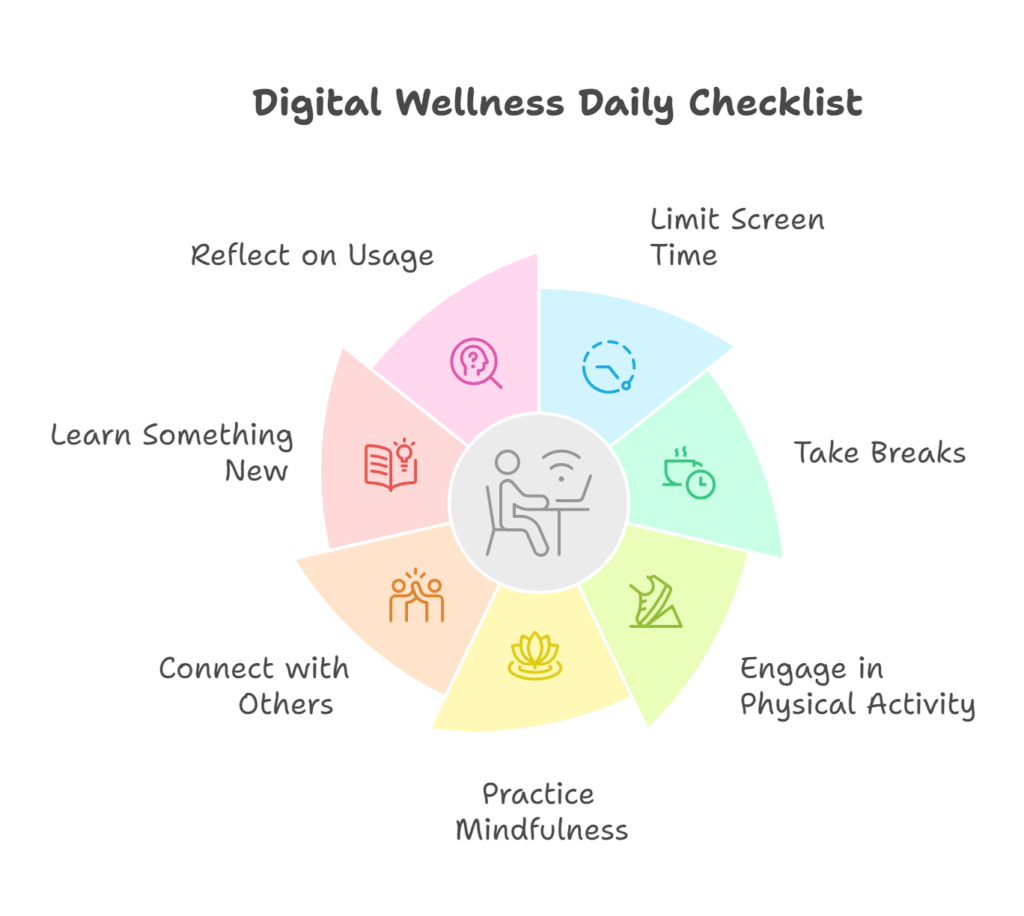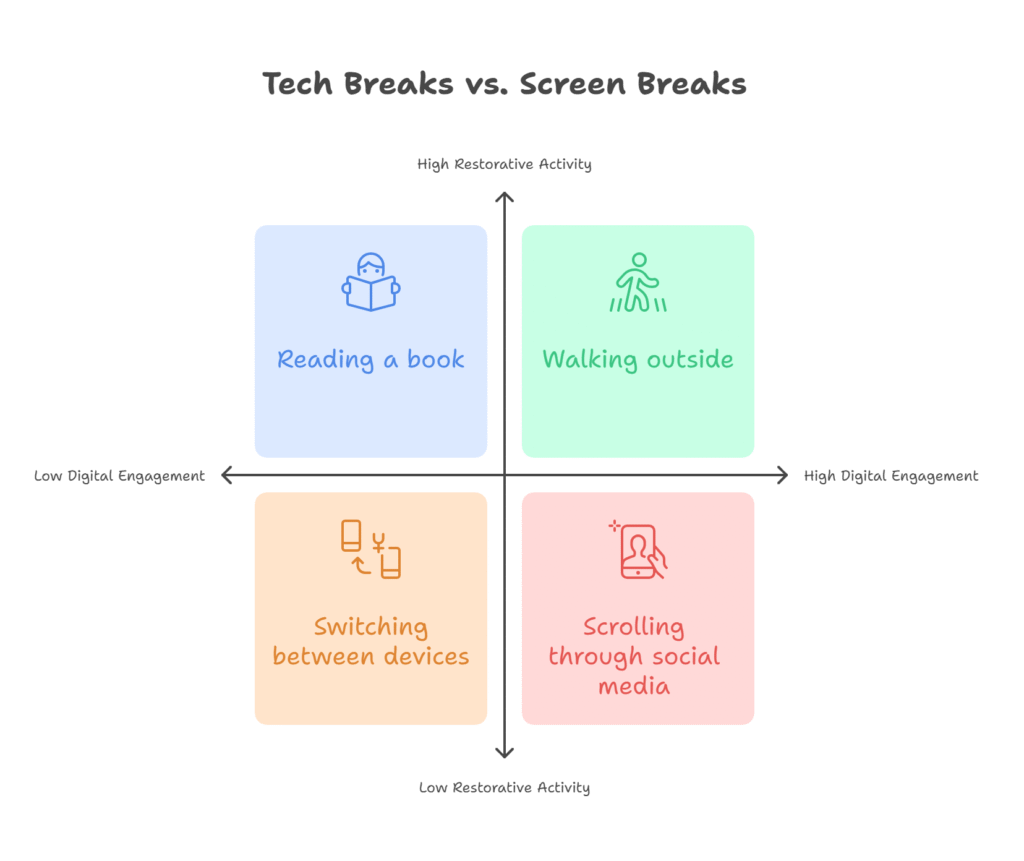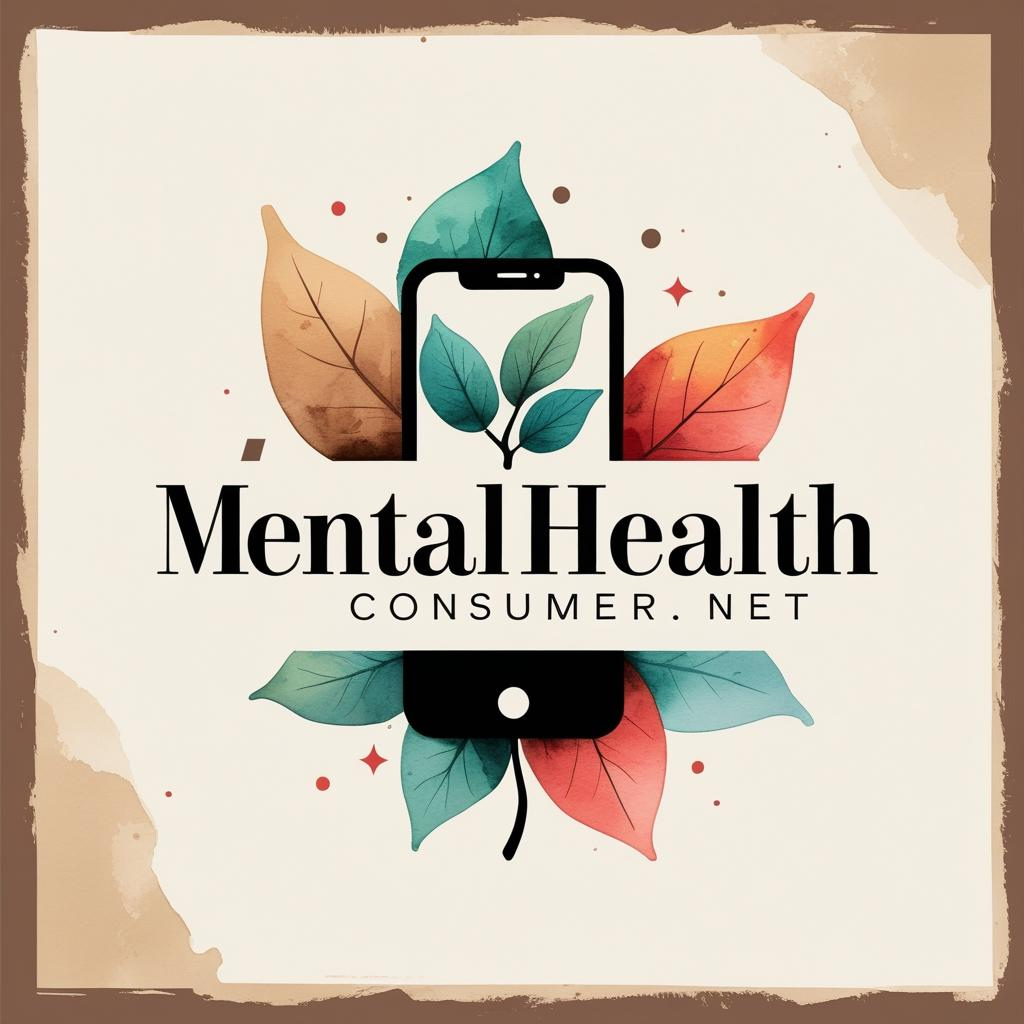Look, I’m not going to pretend I’m some digital wellbeing guru who meditates while my phone sits untouched in another room. Just this morning I caught myself doom-scrolling news at 6 AM while my coffee got cold. Sound familiar?
But here’s what I’ve learned after way too many late nights staring at screens and feeling absolutely drained the next day – digital wellbeing isn’t about going full hermit mode. It’s about getting intentional with how we use the tech that’s basically glued to our hands. And honestly? Some days I nail it, other days… well, let’s just say TikTok wins.
The thing is, we’re all swimming in this digital soup whether we like it or not. So instead of fighting it or feeling guilty about it, what if we just got a little smarter about it?
Start Your Day Without Immediately Grabbing Your Phone
Okay, this one’s tough. I mean, really tough. Your phone is probably within arm’s reach right now, isn’t it? Mine too.
But here’s what happened when I started leaving my phone in the kitchen overnight instead of on my nightstand – mornings got weird. Good weird. Like, I actually had thoughts that weren’t influenced by whatever chaos was happening on my timeline.
Instead of the usual grab-phone-check-everything routine, I started doing this thing where I just… lay there for a minute. Sometimes I think about the day ahead, sometimes I notice how I’m feeling, sometimes I just listen to the birds outside. Revolutionary stuff, right?
The trick isn’t to never touch your phone in the morning – that’s probably not realistic if you have kids calling or work emergencies. It’s more about giving yourself a buffer. Maybe 15 minutes, maybe an hour. Whatever works without making you feel like you’re missing something important.
I’ve noticed that when I start the day by immediately consuming everyone else’s thoughts and problems, I spend the rest of the day feeling reactive instead of intentional. It’s like starting a race before the gun goes off – you’re already behind.
Some mornings I mess this up completely. I’ll wake up, grab my phone “just to check the time,” and suddenly I’m reading about some celebrity drama from 2 AM. Those days tend to feel more scattered, like I’m playing catch-up with myself.
The physical act of keeping your phone somewhere else forces a tiny moment of choice. Do I really need to see what happened in the last seven hours while I was sleeping? Usually, the answer is no. The world managed just fine without my immediate awareness of it.
Create Genuine Tech-Free Zones (And Actually Stick to Them)
This sounds so simple in theory, doesn’t it? Just decide some spaces are phone-free. Done. Except then you’re eating dinner and your phone buzzes and you think “I’ll just quickly check…” and suddenly you’re arguing with a stranger on the internet about pineapple on pizza while your food gets cold.
I started with one rule: no phones during meals. Not groundbreaking, but stick with me. The first few dinners were honestly kind of awkward. What do you do with your hands when they’re not holding a device? Apparently, you eat slower, taste your food more, maybe even have an actual conversation.
But the real game-changer was making my bedroom a phone-free zone. I bought an actual alarm clock – remember those? – and started charging my phone in the living room. The first week was brutal. I’d lie in bed and feel phantom vibrations, convinced I was missing something crucial. Spoiler alert: I wasn’t.
Now I sleep better, and I don’t start every day with the immediate urge to check notifications. Also, reading actual books before bed instead of scrolling Instagram? Total game-changer for how well I sleep.
The bathroom one is harder to admit, but yeah, I had to make that phone-free too. We’ve all been there, right? Planning to spend two minutes and somehow ending up in a 20-minute social media rabbit hole. Not great for productivity, or circulation.
Here’s the thing about tech-free zones – they only work if you’re honest about why you want them. If you’re just doing it because someone said you should, you’ll find excuses. But if you notice that having your phone at dinner makes you feel disconnected from the people you’re with, that’s different. That’s your own reason.
Start small. Pick one space or one time. See how it feels. You might be surprised by what you notice when you’re not distracted by the little glowing rectangle.
Get Smart About Your Notifications (They’re Not All Created Equal)
Let me ask you something – how many times did your phone buzz or light up yesterday? If you’re like most people, it was probably dozens of times. Maybe more. And here’s the crazy part: most of those interruptions were completely unnecessary.
I used to have notifications on for everything. Every email, every social media like, every app update, every news alert. My phone was basically having a constant anxiety attack, and it was making me have one too. Every buzz meant I had to make a decision: check it now or try to ignore it. That’s exhausting.
The breakthrough moment came when I realized notifications are designed to grab your attention, not to serve your wellbeing. That Instagram notification that someone liked your photo from three days ago? It can wait. That email from a store about a sale? Definitely can wait.
So I went on a notification diet. I turned off everything except calls, texts, and maybe one or two apps I actually need for work. The silence was… honestly a little unsettling at first. But then it became peaceful.
Now when my phone makes a noise, it’s usually something that actually matters. And here’s the weird part – I check my phone way less often, but I’m way more responsive to the stuff that’s actually important.
For social media, I turned off all notifications and just check when I want to, not when the app demands my attention. Same with news apps – I’ll catch up on what’s happening when I choose to, not every time something breaks.
The email thing was tricky because work emails can feel urgent. But I realized that very few emails actually require an immediate response. I check email at specific times now instead of being at its mercy all day.
You know what’s interesting? When you’re not constantly interrupted, you can actually focus on stuff. Wild concept, I know.

Take Real Breaks (Not Switching from Work Screen to Fun Screen)
This one took me forever to figure out. I’d finish a long work session on my laptop, feel mentally fried, and think “I need a break.” Then I’d immediately grab my phone and start scrolling. That’s not a break – that’s just different content on a different screen.
Real breaks involve giving your eyes, your brain, and your attention a actual rest. Sometimes that means stepping outside and looking at something farther than two feet away. Sometimes it means moving your body. Sometimes it just means sitting quietly for a few minutes.
I know this sounds incredibly basic, but when’s the last time you took a break that didn’t involve a screen? For me, it had been… embarrassingly long.
Now I try to do this thing where every hour or so, I stand up, walk around, maybe look out the window. The 20-20-20 rule is supposed to be every 20 minutes, look at something 20 feet away for 20 seconds. I’m not that disciplined, but I try to remember to give my eyes a break from staring at pixels.
The best breaks involve moving your body in some way. Even just walking to the kitchen for water is better than scrolling on your phone. Your brain processes things differently when your body is moving, and you come back to whatever you were doing with fresh perspective.
Sometimes I’ll set a timer for a 15-minute break and spend it outside. No phone, no agenda, just being outside. It sounds so simple, but it’s become one of my favorite parts of the day. Weather permitting, obviously – I’m not suggesting you stand in a blizzard for digital wellness.
The key is being intentional about it. A break should restore your energy, not drain it further. Mindless scrolling usually drains energy. Moving your body, getting fresh air, or even just closing your eyes for a few minutes tends to restore it.
Curate Your digital wellbeing Diet Like You’d Curate Your Food
You probably think at least a little bit about what you eat, right? You might avoid foods that make you feel sluggish or choose things that give you sustained energy. But do you think about your digital wellbeing diet the same way?
I started paying attention to how different apps and content made me feel. Instagram sometimes left me feeling inadequate or restless. Twitter often made me angry or anxious. YouTube could either teach me something useful or suck me into a three-hour rabbit hole of random videos.
So I started unfollowing accounts that consistently made me feel worse. Not necessarily because they were bad accounts, but because they weren’t serving my wellbeing. If seeing someone’s perfectly curated life made me feel bad about my own messy reality, why was I choosing to see it every day?
I also started following accounts that actually added value to my life. People who shared knowledge I wanted to learn, artists whose work inspired me, friends whose posts made me smile. Basically, I tried to make my feeds feel more like a good conversation with someone I like, and less like a anxiety-inducing comparison trap.
The news is tricky. Staying informed is important, but getting hit with crisis after crisis all day long isn’t great for anyone’s mental health. I picked one or two trusted news sources and check them once or twice a day instead of having breaking news alerts constantly interrupting my thoughts.
For entertainment content, I got more intentional too. Instead of just mindlessly opening Netflix and scrolling for 20 minutes, I started keeping a list of movies or shows I actually wanted to watch. Same with YouTube – I subscribed to channels I genuinely enjoyed instead of just letting the algorithm decide what I should watch.
It’s funny how much better social media feels when you’re intentional about what you’re consuming. It’s like the difference between mindlessly snacking all day versus sitting down for a meal you actually want to eat.
Wind Down Without Screens (Your Future Self Will Thank You)
I used to be one of those people who’d scroll on their phone until they literally couldn’t keep their eyes open anymore. Then I’d wonder why I had trouble falling asleep or why I’d wake up feeling groggy even after eight hours.
The blue light thing is real, but honestly, it’s not just about the light. It’s about what you’re putting in your brain right before you try to shut it off. News, social media drama, work emails – none of that is exactly conducive to peaceful sleep.
So I started experimenting with a wind-down routine that didn’t involve screens. At first it felt weird and boring. What was I supposed to do for the hour before bed if I wasn’t on my phone?
Turns out, there are options. Reading actual physical books became a big one for me. There’s something about the physical act of turning pages that feels different from staring at a screen. More relaxing, somehow.
Sometimes I’ll do some light stretching or take a shower. Sometimes I’ll write in a journal – just stream-of-consciousness stuff about the day or what’s on my mind. Getting thoughts out of your head and onto paper can be surprisingly helpful for quieting your mind.
I also started doing this thing where I’d tidy up a little bit before bed. Not a deep clean, just putting a few things back where they belong. It makes the next morning feel calmer, and there’s something meditative about simple, repetitive tasks.
The bedroom environment matters too. I invested in blackout curtains and tried to keep the temperature cooler. Made my bedroom feel more like a sanctuary and less like just another room with a bed in it.
The biggest change was probably just accepting that the hour before bed should be boring. Not boring in a bad way, but calm and predictable. My brain doesn’t need more stimulation at 10 PM – it needs to start powering down.

Set Boundaries That Actually Work for Your Life
Here’s where most digital wellbeing advice falls apart – it assumes everyone has the same life and the same relationship with technology. But if you’re a parent, your phone might be your lifeline to your kids’ school. If you work remotely, your laptop is your office. If you live far from family, video calls might be one of your main connections.
So instead of following someone else’s rules, I started figuring out what boundaries actually made sense for my life. Maybe you can’t do a full digital detox weekend, but you could do a few hours on Sunday morning. Maybe you can’t keep your phone out of your bedroom, but you could put it on airplane mode after a certain time.
The trick is being honest about what you actually need versus what you think you need. Do you really need to check email after 8 PM, or has it just become a habit? Do you really need notifications from that shopping app, or is it just creating unnecessary noise in your day?
I started with one small boundary and practiced it until it felt normal, then added another. Trying to overhaul everything at once usually doesn’t stick, at least not for me.
Work boundaries were the hardest. When your job involves being responsive and available, it’s tough to know where to draw lines. But I realized that being constantly available wasn’t actually making me better at my job – it was making me more scattered and less focused when I was working.
So I started experiment with things like checking email at specific times instead of constantly, or having certain hours where I’m fully focused on work and other hours where I’m fully present for personal life. Not perfectly separated – life doesn’t work that way – but more intentional about which mode I was in.
Family boundaries were important too. If you live with other people, your digital habits affect them and vice versa. Having conversations about when it’s okay to be on devices and when it’s time to be present with each other made a huge difference in how we all felt about screen time.
The goal isn’t to create perfect boundaries that you never break. It’s to create guidelines that help you use technology more intentionally, so it serves your life instead of running it.
Quick Takeaways That Actually Matter
- Your phone doesn’t need to be the first and last thing you interact with each day – try creating some buffer time before and after sleep
- Not every notification deserves your immediate attention – be picky about what gets to interrupt your focus
- Real breaks mean stepping away from all screens, not just switching from work apps to social media
- Curate your feeds like you’d curate your food – unfollow stuff that consistently makes you feel worse
- Tech-free zones only work if you actually stick to them, so start with one you can realistically maintain
- Digital boundaries should fit your actual life, not some idealized version of how you think you should live
- The goal isn’t to hate technology, but to use it more intentionally so it serves your wellbeing instead of draining it
The Real Talk About Digital Wellbeing
Look, I’m not going to end this by telling you that following these seven tips will transform your life overnight. Some days you’ll nail the no-phone morning routine, other days you’ll wake up and immediately fall into a social media spiral. That’s being human.
The point isn’t perfection – it’s awareness. Once you start noticing how different digital habits make you feel, you can make choices that serve you better. Maybe you’ll realize that certain apps consistently leave you feeling drained, or that you sleep better when you don’t scroll right before bed.
Technology isn’t going anywhere, and honestly, I don’t think it should. It’s given us incredible tools for learning, connecting, and creating. But like anything powerful, it works best when we’re intentional about how we use it.
Start small, be patient with yourself, and remember that digital wellbeing looks different for everyone. The best approach is the one you’ll actually stick with.

FAQ
How much screen time is too much for adults? There’s no magic number that works for everyone. It’s more about paying attention to how your screen time makes you feel. If you’re consistently tired, anxious, or having trouble sleeping, it might be worth looking at your digital habits. Quality matters as much as quantity – mindlessly scrolling for two hours feels different than spending two hours learning something new online.
What if I need my phone for work? Most digital wellbeing advice assumes you can just put your phone away, but that’s not realistic for everyone. Focus on the boundaries you can control – maybe you can’t avoid work emails, but you could turn off social media notifications during work hours. Or maybe you check work messages at specific times instead of constantly throughout the day.
How do I stop picking up my phone without thinking about it? This automatic phone-grabbing is so common. Try moving your phone to a different location – not necessarily far away, just not in your immediate reach. Having to make even a small physical effort to get it can break the unconscious habit and give you a moment to decide if you actually want to check it.
Is it okay to use my phone to help me fall asleep? If you’re using a meditation app or sleep sounds, that’s different from scrolling social media. But even with helpful apps, the blue light and mental stimulation can interfere with sleep. Try transitioning to audio-only content, or using features like night mode if you do use your phone before bed.
What about staying connected with family and friends? Digital wellbeing isn’t about becoming antisocial. Video calls with loved ones, staying in touch through messaging, sharing photos – these can be really positive uses of technology. The key is being intentional about it rather than mindlessly consuming content that doesn’t add value to your relationships.
How long does it take to adjust to new digital habits? Everyone’s different, but expect it to feel uncomfortable for the first week or two. Your brain is used to the constant stimulation, so periods without it might feel boring or restless at first. Most people find that new habits start feeling more natural after about three weeks of consistent practice.
What if my family isn’t on board with tech-free times? Start with yourself first. Model the behavior you want to see, and others might naturally follow. If you want family tech-free time, try suggesting activities that are genuinely appealing – cooking together, going for walks, playing games – rather than just asking people to give up their devices without offering something better in return.



